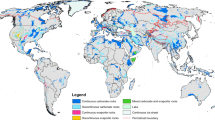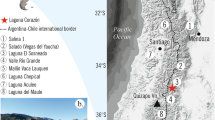Abstract
We used a 55-cm sediment core from shallow Chaiwopu Lake in the central Tianshan Mountains of Xinjiang, northwest China, to investigate climate and environmental changes in this arid region over the past ~150 years. The core was dated using 137Cs. We compared temporal changes in several sediment variables with recent meteorological and tree-ring records. Organic matter had a positive correlation with the Palmer Drought Severity Index in the central Tianshan Mountains, and the δ13C of organic matter had a positive correlation with regional temperature. We applied constrained incremental sum-of-squares cluster analysis to element concentrations in the core and identified three distinct zones: (1) 55–46 cm, ~1860–1910, (2) 46–26 cm, ~1910–1952, and (3) 26–0 cm, 1952–present. Between 1880 and 1910 AD, following the Little Ice Age (LIA), the sediment environment was relatively stable, climate was cold and dry, and the lake water displayed high salinity, in contrast to conditions during the LIA. During the LIA, westerlies carried more water vapor into Central Asia when the North Atlantic Oscillation was in a negative phase, and encountered the enhanced Siberia High, which probably led to increased precipitation. In the period 1910–1950 AD, the lake was shallow and the regional climate was unstable, with high temperatures and humidity. In the last ~15–20 years, human activities caused an increase in sediment magnetic susceptibility, and heavy metal and total phosphorus concentrations in the sediment were substantially enriched. Mean annual temperature displays a warming trend over the past 50 years, and the lowest temperature was observed in the 1950s. There has been an increase in annual total precipitation since the 1990s. The combined influences of climate and human activity on the lake environment during this period were faithfully recorded in sediments of Chaiwopu Lake. This study provides a scientific basis for environmental management and protection.






Similar content being viewed by others
References
Appleby P, Nolan P, Gifford D, Godfrey M, Oldfield F, Anderson NJ, Battarbee RW (1986) 210Pb dating by low background gamma counting. Hydrobiologia 143:21–27
Appleby P, Richardson N, Nolan P (1992) Self-absorption corrections for well-type germanium detectors. Nucl Instrum Meth B 71:228–233
Austin P, Mackay A, Palagushkina O, Leng M (2007) A high-resolution diatom-inferred palaeoconductivity and lake level record of the Aral Sea for the last 1600 yr. Quaternary Res 67:383–393
Boulay S, Colin C, Trentesaux A, Pluquet F, Bertaux J, Blamart D, Buehring C, Wang P (2003) Mineralogy and sedimentology of Pleistocene sediment in the South China Sea (ODP Site 1144). In: Prell WL, Wang P, Blum P, Rea DK, Clemens SC (ed) Proceedings of ocean drilling program scientific results, vol 184, pp 1–21
Bradley R (2000) 1000 years of climate change. Science 288:1353–1354
Brenner M, Whitmore TJ, Curtis JH, Hodell DA, Schelske CL (1999) Stable isotope (δ13C, δ15N) signatures of sedimented organic matter as indicators of historical lake trophic state. J Paleolimnol 22:205–221
Brohan P, Kennedy JJ, Harris I, Tett SFB, Jones PD (2006) Uncertainty estimates in regional and global observed temperature changes: a new dataset from 1850. J Geophys Res 111:D12106. doi:10.1029/2005JD006548
Brönnimann S, Ewen T, Luterbacher J, Diaz HF, Stolarski RS, Neu U (2007) A Focus on climate during the Past 100 Years. In: Brönnimann S, Luterbacher J, Ewen T, Diaz HF, Stolarski RS, Neu U (eds) Climate variability and extremes during the past 100 years. Springer, Berlin, pp 1–25
Chen K, Bowler JM, Kelts K (1990) Palaeoclimatic evolution within the Qinghai-Xizang (Tibet) Plateau in the last 40000 years. Quat Sci 1:21–31 (in Chinese with English abstract)
Chen F, Shi Q, Wang J (1999) Environmental changes documented by sedimentation of Lake Yiema in arid China since the Late Glaciation. J Paleolimnol 22:159–169
Chen J, Wan G, Zhang DD, Zhang F, Huang R (2004) Environmental records of lacustrine sediments in different time scales: sediment grain size as an example. Sci China Ser D 47:954–960
Chen F, Huang X, Zhang J, Holmes JA, Chen J (2006) Humid little ice age in arid central Asia documented by Bosten Lake, Xinjiang, China. Sci China Ser D 49:1280–1290
Chen F, Chen J, Holmes J, Boomer I, Austin P, Gates JB, Wang N, Brooks SJ, Zhang J (2010) Moisture changes over the last millennium in arid central Asia: a review, synthesis and comparison with monsoon region. Quat Sci Rev 29:1055–1068
Crowley TJ (2000) Causes of climate change over the past 1000 years. Science 289:270–277
Engstrom DR, Wright HE Jr (1984) Chemical stratigraphy of lake sediments as a record of environmental change. In: Haworth EY, Lund JWG (eds) Lake sediments and environmental history. University of Minnesota Press, Minneapolis, pp 11–67
Gao C, Liu J (1990) Study on loess along the Urumqi River valley. Quat Sci 3:251–260 (in Chinese with English abstract)
Grimm EC (1987) CONISS: a FORTRAN 77 program for stratigraphically constrained cluster analysis by the method of incremental sum of squares. Comput Geosci UK 13:13–35
Guan Q, Pan B, Li N, Li Q, Hu Z, Gao H, Xu S, Wang Y (2010) An indicator of sand storms in the south of the Tengger Desert. Theor Appl Climatol 102:197–203
Hayes J (1993) Factors controlling 13C contents of sedimentary organic compounds: principles and evidence. Mar Geol 113:111–125
Hu S, Deng C, Appel E, Verosub KL (2002) Environmental magnetic studies of lacustrine sediments. Chin Sci Bull 47:613–616
IPCC (2007) Climate change 2007: the physical science basis. Contribution of working group I to the fourth assessment report of the intergovernmental panel on climate change. Cambridge University Press, Cambridge
Jones PD, Moberg A (2003) Hemispheric and large-scale surface air temperature variations: an extensive revision and an update to 2001. J Climate 16:206–223
Juggins S (2002) http://www.staff.ncl.ac.uk/staff/stephen.juggins/software/ZoneHome.htm
Kump LR, Arthur MA (1999) Interpreting carbon-isotope excursions: carbonates and organic matter. Chem Geol 161:181–198
Li J, Gou X, Cook ER, Chen F (2006a) Tree-ring based drought reconstruction for the central Tien Shan area in northwest China. Geophys Res Lett 33:L07715. doi:10.1029/2006GL025803
Li Y, Yang Y, Han J, Xie Z, Masayoshi N, Kumiko G (2006b) Persistent decrease of dust burden for about 100 years over middle-upper troposphere of the southern Taklimakan Desert, China. J Glaciol Geocry 28:873–878 (in Chinese with English abstract)
Lioubimtseva E (2004) Climate change in arid environments: revisiting the past to understand the future. Prog Phys Geog 28:502–530
Lioubimtseva E, Henebry GM (2009) Climate and environmental change in arid Central Asia: impacts, vulnerability, and adaptations. J Arid Environ 73:963–977
Liu H, Xu L, Cui H (2002) Holocene history of desertification along the woodland-steppe border in northern China. Quaternary Res 57:259–270
Liu Z, Colin C, Trentesaux A, Siani G, Frank N, Blamart D, Farid S (2005) Late Quaternary climatic control on erosion and weathering in the eastern Tibetan Plateau and the Mekong Basin. Quat Res 63:316–328
Ma L, Wu J, Yu H, Zeng H, Abuduwaili J (2011a) The medieval warm period and the Little Ice Age from a sediment record of Lake Ebinur, northwest China. Boreas 40:518–524
Ma L, Wu J, Abuduwaili J (2011b) The climatic and hydrological changes and environmental responses recorded in lake sediments of Xinjiang, China. J Arid Land 3:1–8
Ma L, Wu J, Abuduwaili J (2011c) Area change of Chaiwopu Lake and its environmental effects in the past 30 years. Arid Land Geogr 34:649–653 (in Chinese with English abstract)
Melillo JM, McGuire AD, Kicklighter DW, Moore B, Vorosmarty CJ, Schloss AL (1993) Global climate change and terrestrial net primary production. Nature 363:234–240
Meyers PA, Teranes JL (2001) Sediment organic matter. In: Last WM, Smol JP (eds) Tracking environmental change using lake sediments. Physical and geochemical methods, vol 2. Kluwer Academic Publishers, Dordrecht, pp 239–269
Miller KM, Heit M (1986) A time resolution methodology for assessing the quality of lake sediment cores that are dated by 137Cs. Limnol Oceanogr 31:1292–1300
Oldfield F, Battarbee RW, Boyle JF, Cameron NG, Davis B, Evershed RP, McGovern AD, Jones V, Thompson R (2010) Terrestrial and aquatic ecosystem responses to late Holocene climate change recorded in the sediments of Lochan Uaine, Cairngorms, Scotland. Quat Sci Rev 29:1040–1054
Reasoner MA (1993) Equipment and procedure improvements for a lightweight, inexpensive, percussion core sampling system. J Paleolimnol 8:273–281
Ritchie JC, McHenry JR, Gill AC (1973) Dating recent reservoir sediments. Limnol Oceanogr 18:254–263
Shi Y, Wen Q, Qu Y (1990) Researches on the water resources in Urumqi region (II): the quaternary climo-environment change and hydrogeological condition of Chaiwopu Basin in Xinjiang region. China Ocean Press, Beijing (in Chinese)
Shi Y, Shen Y, Kang E, Li D, Ding Y, Zhang G, Hu R (2007) Recent and future climate change in northwest China. Clim Change 80:379–393
Sorrel P, Popescu S-M, Head MJ, Suc JP, Klotz S, Oberhänsli H (2006) Hydrographic development of the Aral Sea during the last 2000 years based on a quantitative analysis of dinoflagellate cysts. Palaeogeogr Palaeocl 234:304–327
VandenBygaart AJ, Protz R, Tomlin AD, Miller JJ (1998) 137Cs as an indicator of earthworm activity in soils. Appl Soil Ecol 9:167–173
Wang J, Jiao K (1989) Geomorphology, quaternary sediments and lake-level change in Chaiwopu-Dabancheng region. In: Shi Y, Qu Y (eds) Researches on the water resources in Urumqi region (I): water resources and environment in Chaiwopu-Dabancheng region. Science press, Beijing, pp 11–21 (in Chinese)
Wang NL, Yao TD, Yang XD, Shen J, Wang Y (2007) Variations in dust event frequency over the past century reflected by ice-core and lacustrine records in north China. Sci China Ser 50:736–744
Wu J (1995) Characters of the evolution of climate and environment during the last 10 ka years in Aibi Lake region, Xinjiang. Sci Geogr Sinica 15:39–46 (in Chinese with English abstract)
Wu J, Ma L (2010) Characteristics of the climate and environment in arid regions over the past 150 years recorded by the core sediments of Chaiwopu Lake, Xinjiang, China. Quat Sci 30:1137–1144 (in Chinese with English abstract)
Wu J, Schleser GH, Lücke A, Li S (2007) A stable isotope record from freshwater lake shells of the eastern Tibetan Plateau, China, during the past two centuries. Boreas 36:38–46
Wu J, Yu Z, Zeng H, Wang N (2009) Possible solar forcing of 400-year wet–dry climate cycles in northwestern China. Clim Change 96:473–482
Yao T, Thompson LG, Qin D, Tian L, Jiao K, Yang Z, Xie C (1996) Variations in temperature and precipitation in the past 2000 years on the Xizang (Tibet) Plateau-Guliya ice core record. Sci China Ser 4:425–433
Zhong W, Xue J, Li X, Xu H, Ouyang J (2010) A Holocene climatic record denoted by geochemical indicators from Barkol Lake in the northeastern Xinjiang, NW China. Geochem Int 48:792–800
Acknowledgments
We thank Zeng Haiao and Lan Cejie for field assistance. Thanks are due to Mark Brenner for his helpful comments and the revision of the English text. We also thank anonymous reviewers for their valuable comments and constructive suggestions. This study was supported by the Knowledge Innovation Program of the Chinese Academy of Sciences (KZCX2-EW-308), the National Basic Research Program of China (no. 2012CB956102), National Natural Science Foundation of China (U113830; 41101190), West Doctor Project of West Light Foundation of The Chinese Academy of Sciences (XBBS201106), and China Postdoctoral Science Foundation (20110491752). The author gratefully acknowledges the support of K. C. Wong Education Foundation, Hong Kong.
Author information
Authors and Affiliations
Corresponding author
Rights and permissions
About this article
Cite this article
Ma, L., Wu, J. & Abuduwaili, J. Climate and environmental changes over the past 150 years inferred from the sediments of Chaiwopu Lake, central Tianshan Mountains, northwest China. Int J Earth Sci (Geol Rundsch) 102, 959–967 (2013). https://doi.org/10.1007/s00531-012-0838-4
Received:
Accepted:
Published:
Issue Date:
DOI: https://doi.org/10.1007/s00531-012-0838-4




